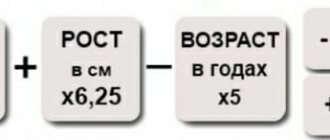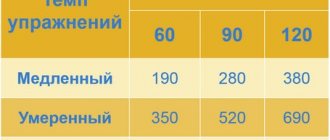Exhausting workouts and fitness will not help you lose weight if an excess amount of calories enters the human body. Experts call this a surplus. If there is a deficiency or deficiency, kilograms are lost even with absolute rest. Knowing how to calculate your daily intake is necessary not only for being slim. Sometimes you need to gain weight or maintain the desired weight.
The most popular method for calculating your daily calorie intake is the Mifflin San Geor formula. It is used all over the world. But there are other options.
What is basal metabolism?
Calculation of daily caloric intake begins with the calculation of the basal metabolic rate (BMR) - the amount of energy required by the body to support vital processes. The human body, even when at rest, constantly expends calories for breathing, digestion, blood circulation and other physiological processes. The daily caloric intake must be higher than the BMR, otherwise the body will not be able to function normally.
The level of basal metabolism can be determined by two methods: direct and indirect.
In the first case, a person is placed in a special chamber, where the amount of heat he consumes is measured, after which the PBM is calculated. This research method is the most accurate, but at the same time inaccessible.
The indirect method involves calculating basal metabolism using a special formula. Today there are several main methods of calculation. Let's list the main ones.
Harrison-Benedict formula calorie calculation
The formula was developed by the American physiologist Francis Gano Benedict and botanist James Arthur Harris at the beginning of the last century, but still remains relevant. Has an error of about 5%.
The formula for calculating the PBM is as follows:
- For women: 655.1 + (9.563 × weight in kg) + (1.85 × height in cm) - (4.676 × age in years);
- For men: 66.5 + (13.75 × weight in kg) + (5.003 × height in cm) - (6.775 × age in years).
The result obtained is the daily calorie intake required by the body for normal functioning. To calculate how many kcal you need to consume to maintain weight, you need to multiply the resulting figure by the physical activity coefficient:
- 1.2 – minimal (sedentary work, lack of physical activity);
- 1.375 – low (training for at least 20 minutes 1-3 times a week);
- 1.55 – moderate (workouts 30-60 minutes 3-4 times a week);
- 1.7 – high (workouts 30-60 minutes 5-7 times a week; heavy physical work);
- 1.9 – extreme (several intense workouts a day 6-7 times a week; very labor-intensive work).
Basic concepts for calculating calories per day
Systematically exceeding the required number of kilocalories leads to a subsequent increase in body weight. Then comes insulin resistance, obesity and diabetes - the scourge of the last 50 years.
Insufficient intake risks weight loss even when it is not needed. Some people cannot lose weight, while another person is trying with all his might to gain at least a couple of kilograms. Only they are quickly lost if you don’t watch your diet.
In any case, the main reason for weight deviation from the norm is excess or deficiency of daily calorie intake. To solve the problem, you need to arm yourself with a calculator, a pencil, scales, and a piece of paper.
The formulas of WHO, Mifflin and San Geor, Harris-Benedict, Tom Venuto, Catch-McArdle are used by nutritionists, nutritionists, professional athletes and adherents of healthy lifestyle and nutritional supplements. In most cases, calculations are made for weight loss.
Why count calories?
In 99% of cases, the use of all formulas, including those from Mifflin and San Geor, has one goal - to say goodbye to fat and nasty folds. I want to do this correctly, once and for all. If you lose weight incorrectly, the extra pounds usually come back and bring friends.
Formulas are also essential for gaining muscle mass. It is actively used by professional athletes and amateurs. Calorie calculation is practiced in the treatment of eating disorders (ED): compulsive overeating, bulimia, anorexia. KBJU is calculated to create a balanced menu. This is done by nutritionists, nutritionists, and nutrition coaches.
Do you accurately calculate the calorie content of your daily menu?
Not really
Mifflin-San Geor formulas are used in catering establishments - sanatoriums, boarding houses and industrial canteens. The portion, set of products, and composition of the dish for an office worker are significantly less than for a miner. The level of activity, the body's need for nutritional supplements, and energy are taken into account. Also, calculating calories for weight loss is used at home by the most ordinary people trying to get themselves in order on their own.
Daily calorie intake - what is it?
The norm is the optimal calorie content that is required for the body to function properly. At the same time, the weight is stable, the amount of fat does not decrease or increase. The amount of fat and muscle tissue remains at the same level. A person has enough energy to perform basic tasks, move, and live a full-fledged lifestyle.
People of the same gender do not always have the same standards. Gender, weight, height, age, daily activity, basal metabolism and a number of other factors are taken into account.
How to calculate your basal metabolic rate?
Everyone around is talking about metabolism. For some reason it needs to be accelerated, supported, accelerated. Only a few people are familiar with this concept. Let's be clear.
Basic metabolic rate (BMR) is the minimum number of calories required by the body to perform vital functions at rest. A person burns energy even during sleep. It is spent on breathing, blood circulation and other metabolic processes. The basal metabolic rate is also called the basal metabolic rate or BMR.
What else affects the indicator:
- hormonal background;
- weight;
- genetics;
- floor;
- body type;
- age.
Maximum energy is spent by the brain, liver, and muscle tissue. The heart, liver, other organs, and internal systems require less. In any case, to determine caloric content, it is necessary to correctly calculate caloric intake. You can use the nominal calculation formulas of scientists, but some people trust WHO data more.
The most popular formulas are Harris-Benedict and San Geor-Mifflin. They take into account various factors that affect metabolic rate. It is impossible to accurately calculate basal metabolism down to the last kilocalorie. Even body temperature, room temperature, and air humidity have an effect.
Scientists have found that basal metabolism decreases with age. Therefore, after 30 years, body weight begins to increase. If you do not reduce your calorie intake, obesity appears.
Which activity coefficient should I choose for calculation?
We all lead different lives. With a lack of activity or lack of physical activity, a minimum amount of kilocalories is required daily. During heavy training or manual labor, energy expenditure is much greater. Some formulas for calculating calories for weight loss take into account the intensity of daily exercise. Therefore, such an indicator as the daily activity coefficient was introduced. Which one and when to choose?
- For sedentary work and a sedentary lifestyle, the lowest value is 1.2.
- If you have sports a couple of times a week, a little exercise, if there is walking, then choose a coefficient of 1.37.
- For regular training 3-4 times a week, choose 1.55.
- If you exercise 5-6 times a week – 1.7.
- Hard physical labor and intense daily training require an increase in level by 1.9%.
For convenience, the main coefficients are included in the table in the section describing the formula for calculating calories using the San Geor and Mifflin method.
Calorie calculation using the Mifflin-San Geor formula
The method for calculating daily caloric intake was developed by nutritionists under the guidance of doctors Mifflin and San Geor. The formula was developed relatively recently, but today it is the most accurate. It helps to calculate the required amount of kcal for a person aged 13 to 80 years.
Simplified version (without taking into account physical activity)
- For women: (10 x weight in kg) + (6.25 x height in cm) – (5 x age in g) – 161;
- For men: (10 x weight in kg) + (6.25 x height in cm) – (5 x age in g) + 5.
Online calorie calculators
All automatic calculations are very convenient and captivating in their simplicity. However, if you have any doubts about the correct operation of the online calculator, you can calculate the quantities you are interested in yourself. To do this, we provide not only automatic calculations, but the formulas themselves.
Basic concepts and different calculation methods will help determine the calorie corridor with maximum accuracy.
Please note that if you change your weight and lifestyle, it is necessary to update the standards. Therefore, I recommend bookmarking the article so that it is at hand. In the process of losing weight, recalculate every 5 kg of weight lost. To standardize indicators, use the same method.
The online calorie calculator contains two of the most popular formulas: Harris-Benedict and Mifflin-Saint-Geor. You can use each of them and use the average value for weight loss.
World Health Organization (WHO) formula
The World Health Organization provides recommendations on how to calculate your daily caloric intake:
- For women from 18 to 30 years old (0.062 x weight in kg + 2.036) x 240 x CFA;
- For women from 31 to 60 years old (0.034 x weight in kg + 3.538) x 240 x CFA;
- For women over 60 years old (0.038 x weight in kg + 2.755) × 240 x CFA;
- For men from 18 to 30 years old (0.063 x body weight in kg + 2.896) x 240 x CFA;
- For men from 31 to 60 years old (0.484 x body weight in kg + 3.653) x 240 x CFA;
- For men over 60 years of age (0.491 x body weight in kg + 2.459) x 240 x CFA.
Where CFA is the coefficient of physical activity: 1 - low, 1.3 - average, 1.5 - high.
Daily energy norms - tables
If you are a woman, you are 30 years old, you work in an office and regularly play sports, then your calorie intake will be from 1800 kcal to 2200 kcal. A more accurate figure for calculations using the formula will only be a random choice that does not guarantee additional accuracy.
Among other things, the level of absorption of plant proteins does not exceed 50-70%, and the fiber contained in the products is not absorbed at all (although it is included in the “carbohydrates” column) - that is, the nutritional value indicated on the packaging is considered exclusively mathematical.
Calorie norm table for women
| Age | Activity level | Calorie norm |
| 17 – 40 years | Short | 1800-2000 kcal |
| Average | 2000-2200 kcal | |
| High | 2200-2400 kcal | |
| 41 – 60 years | Short | 1600-1800 kcal |
| Average | 1800-2000 kcal | |
| High | 2000-2200 kcal | |
| Over 61 years old | Short | 1600 kcal |
| Average | 1800 kcal | |
| High | 2000 kcal |
After reaching the age of 40, women's metabolic rate usually decreases. Against this background, a decrease in estrogen levels after menopause leads to a change in the body's sensitivity to carbohydrates - and the associated excess weight gain. On average, women gain from 5 to 7 kg.
// At what age does metabolism begin to slow down?
Calorie norm table for men
| Age | Activity level | Calorie norm |
| 17 – 40 years | Short | 2400-2600 kcal |
| Average | 2600-2800 kcal | |
| High | 3000-3200 kcal | |
| 41 – 60 years | Short | 2000-2200 kcal |
| Average | 2400-2600 kcal | |
| High | 2600-2800 kcal | |
| Over 61 years old | Short | 2000 kcal |
| Average | 2200-2400 kcal | |
| High | 2400-2600 kcal |
Male metabolism is characterized by testosterone levels - this hormone helps maintain muscle mass and burn fat. However, after 30-35 years, testosterone begins to fall - against the background of a sedentary lifestyle and poor nutrition, this leads to the growth of belly fat.
// How to quickly remove belly fat for a man?
Calorie norm table for children and adolescents
| Age | Activity level | Calorie norm |
| 14 years | Short | 1000 kcal |
| Average | 1200-1400 kcal | |
| High | 1400-1600 kcal | |
| 5 – 8 years | Short | 1200-1400 kcal |
| Average | 1400-1600 kcal | |
| High | 1600-1900 kcal | |
| 9 – 11 years | Short | 1500-1800 kcal |
| Average | 1800-2000 kcal | |
| High | 1900-2200 kcal | |
| 12 – 16 years old | Short | 1600-1800 kcal |
| Average | 2000-2500 kcal | |
| High | 2500-3000 kcal |
The reason for the growth of the belly in teenagers is the love of sweets and snacks. Eating children fast carbohydrates (sugar, honey, cornflakes, candies, chocolate) provokes negative hormonal changes, including those related to brain function.
// How can a teenager lose belly fat and pump up his abs?
How to properly reduce daily calorie intake to lose weight?
For harmonious and safe weight loss, it is recommended to reduce the caloric content of the diet, taking into account physical activity, by 10-15% (by 20% for severe obesity). The daily calorie content should not be lower than the following indicator:
Weight in kg/0.45 x 8
WHO recommends reducing food intake by 500 kcal per month from the actual diet until the calorie content is 300-500 kcal below the daily requirement.
Reducing the daily intake by 500 kcal per day leads to a loss of approximately 500 grams of fat mass per week. After six months of such weight loss or upon reaching your ideal weight, it is recommended to recalculate the daily calorie intake taking into account new indicators.
You shouldn’t cut your calorie intake as much as possible to lose weight more effectively. A loss of 250-500 grams per week is considered physiological and safe for health. Exceeding these numbers means loss of muscle and fluid.
Useful mobile applications
Applications that make it convenient to count calories and adjust your diet can be downloaded to your mobile device. The following programs deserve special attention:
Mobile applications for calorie counting
- MyFitnessPal . Counts the total amount of calories consumed and shows how much protein, fat and carbohydrates were eaten. 6 million products are included in the service database, and the list is updated daily. MyFitnessPal allows you to keep a workout diary and plan individual exercises. Advanced functionality and a synchronization option make using the application as comfortable as possible.
- Lifesum . Replaces a nutritionist who creates a nutrition plan for losing excess weight. The menu consists of simple recipes from familiar products. Lifesum will tell you what your serving size should be and display how many calories you consumed. The service is focused on healthy eating. In addition, he emphasizes the amount of water you drink and suggests effective physical exercise.
- FatSecret . Calorie, protein, fat and carbohydrate counter. In addition, the service records how much cholesterol, salt, fiber and sugar entered the body. The user can view statistics for the day, as well as for the current and previous week. FatSecret measures calorie expenditure during multiple types of physical activity. To make the readings 100% accurate, you can connect a heart rate monitor.
- “ Let's lose weight together. Calorie Diary ." This is one of the best programs for keeping your body in good shape. Its main task is to select a diet that will correspond not only to a person’s height, age and weight, but also to his taste preferences. The program includes many tips on healthy eating and a body mass index chart. The application collects statistics on progress in losing weight, giving recommendations for adjusting your diet and lifestyle.
- " Proper nutrition ." After downloading the program, the new user is asked to enter his personal data: gender, age, height, weight, level of physical activity, diet. The service will analyze the information and show the optimal amount of calories, water and the ratio of BJU. You will be able to view recipes for dishes with colorful pictures and detailed descriptions.
Counting calories is important to correctly determine your daily food intake. At the same time, it is important not to forget that you need to not only meet your daily caloric intake, but also make sure that the food is varied, healthy, and tasty.
Proteins, fats and carbohydrates when counting calories
Effective weight loss is not only about maintaining daily calorie intake, but also about proper distribution of proteins, fats and carbohydrates. A balanced diet according to the BJU ratio will look like this:
- For weight loss: 30-35% proteins, 30-35% fats, 30-40% carbohydrates;
- To maintain weight: 25-35% proteins, 25-35% fats, 40-50% carbohydrates;
- For weight gain: 35-40% proteins, 15-25% fats, 40-60% carbohydrates.
With this distribution of BJU in the diet, the body receives sufficient quantities of nutrients and vitamins.
Do not forget that all formulas for calculating daily calorie content may have errors. They do not take into account the percentage of food absorption, health status, metabolic rate and other factors. Even a diet compiled by a specialist may not work in a particular case due to the individual characteristics of a person. In the process of building a beautiful, strong body, you should listen to your feelings, and, if necessary, change your diet and the ratio of KBJU.
Watch your diet, exercise, and the results will not take long to arrive!
Application of the obtained data in practice
When calculating the caloric content of the diet is completed, all that remains is to select food that will correspond to the data obtained. At the same time, it is important to ensure that there is no deficiency of vitamins, minerals, fiber and other valuable elements involved in the functioning of organs and systems.
You should eat a varied diet. It is necessary to include dairy and fermented milk products, fish, meat, fruits, cereals, fresh vegetables and fruits, and nuts in the diet.
Do not forget that each product has its own calorie content:
- buckwheat – 335 calories per 100 grams;
- white rice – 330 kcal, and brown rice – 116 kcal;
- oatmeal – 303 kcal;
- low-fat cottage cheese – 71 kcal;
- kefir – 30 kcal;
- bananas – 89 kcal, apples – 45 kcal;
- white cabbage – 27 kcal;
- carrots – 34 kcal;
- pollock – 78 kcal;
- beef – 193 kcal;
- chicken breast – 124 kcal.
In addition to a balanced diet, it is recommended to exercise and take frequent walks in the fresh air.











